Abstract
Tourism is recognized as a very important sector for increasing GDP, creating new jobs, activating the balance of international trade. However, fierce competition in tourism sector may lead to the negative economic consequences. The article aims to carry out the economic evaluation of Lithuanian tourism development indicators. In order to achieve this aim different methods were used: critical analysis of scientific sources, comparative and systematic analysis of statistical data, correlation analysis (Pearson correlation coefficient). The impact of tourism on economic growth was assessed by analysing the changes in the GDP multiplier effect of investments attracted by tourism cluster, taxes collected, and multiplier effect. It was found that the consumption of tourism products has a significant impact on GDP. Tourism consumption reflects on accommodation establishments on the basis of income and their impact on GDP, created in Lithuania. Confirmed the statistical causality of tourism development and the economic situation in the country. Business development in the tourism sector, establishing new and expanding already existing enterprises create favourable conditions for the establishing new job vacancies, helps to tackle unemployment rates.
Keywords: Lithuanian tourism development economic evaluationtourism developmenttourism development economic impact
Introduction
Tourism business development level in the XX century led to the recognition of tourism as a phenomenon. In many countries tourism is important for creating GDP, new jobs, activating the balance of international trade. In the modern market, tourism opens up quite a lot of new opportunities for different types of business and stimulates economic growth. The results of the research confirm that tourism has a significant impact on construction, agriculture, production of consumer goods and is therefore analysed as a catalyst for socioeconomic development and is recognized as a priority economic activity in many countries. Business structures and state institutions are increasingly interested in the impact of tourism on economic growth. Economic growth caused by tourism is an important subject of discussion to create country and region development plans, planning economic development, marketing tools and making business promotion decisions.
Every country participating in international tourist exchanges seeks to promote inbound tourism in order to strengthen its positive economic impact. The pursuit of economic benefits in the current period and active competition in the tourism market can lead to aggressive development of tourism, irrespective of the capacity of the region's tourist resources and infrastructure, which in the longer term is more linked to the negative impact of tourism business on the economy and the weakening of the region's competitiveness on the international market. The UN, WTO experts and academics from different countries are paying a lot of attention to this issue.
-
To study the theoretical aspects of tourism development and its evaluation.
-
To describe the importance of tourism for the country's economic development.
-
To determine the impact of Lithuanian tourism development on Lithuania's economic growth.
Literature Review and Theoretical Framework
Business structures and governmental institutions are more and more interested in the impact of tourism on economic growth. Tourism-driven economic growth is an important subject of discussion for creating country and region development plans, planning economic development, marketing tools and making business stimulation decisions.
Tourism is an active generator of cross-border exchange of goods manufactured by different industries. The tourism industry by its nature is not only oriented to residents of the country. Foreign tourists use the supply of local tourism market operators, natural resources, pay for utilities, and all this have a positive impact on the local economy. Travelers going to another country increase the volume of trade, financial income, which creates jobs, helps to collect more taxes and stimulate other economic activities. The economic impact created on the basis of foreign tourists' expenses can be analysed as the basis for the economic product of inbound tourism impact to economic growth.
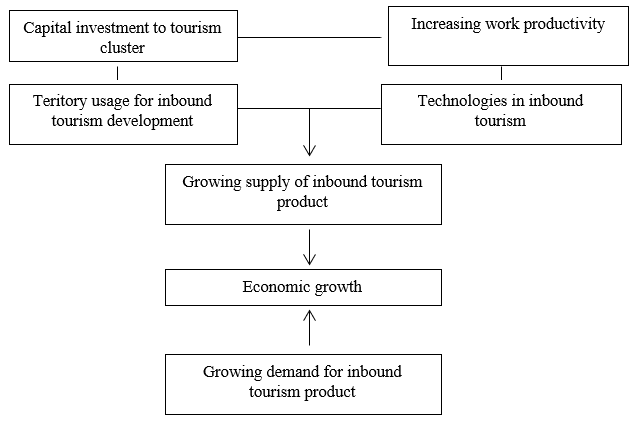
As shown in Figure
Many experts consider tourism as a highly capital-intensive business. This is due to the complex structure of the tourism industry, characterized by complex interconnections and a large investment-intensive infrastructure. Halloway (2012), analysing the impact of tourism on the national economy, highlighted the problem of this assessment. It is impossible to separate tourism development from the overall economic development of the country, investments in the tourist cluster are closely linked to investments in other sectors of the economy and due to their economic capacity (Kvartalnov, 2000). Tourism is a rather attractive area for investment: some tourism businesses do not require large investments in the beginning; the market for tourism is successful for large, medium and small enterprises; tourism companies have intensive capital flow; it is possible to benefit from currency operations because of inbound tourism (Kurbatov, 1997).
Increasing labour productivity in tourism business cannot be considered unambiguously. Tasks distribution, sharing and work performance in tourism must be based on rationality principles, but traditional productivity measures as much as it is related to industrial production, can hardly be transferred to tourism sector, as such work method may be unacceptable for visitors (McIntosh, 1995). Unlike in a day-to-day environment, during the trip other values are highlighted, with particular emphasis on personal service, for which some segments of visitors are determined to pay quite a lot of money.
Serving visitors at the same time can be complex and specific: complex because it offers a satisfaction of the whole tourist needs, specific because its organization and structure are fundamentally different from the service in a permanent place of residence. The level of complexity and specificity is one of the most important criteria for tourist service quality (Occupation in the Tourist Sector, 1994).
One example of complexity is the effective use of territories, which can be expressed in the ability to combine different economic goals and functional purpose. It opens up broad opportunities for economic activities development, usage of available natural resources. It is also possible to harmonize certain aspects of the activities, such as hydroelectric activities and the recreational use of water bodies. The result is greater economic benefit.
The increasingly dominant need for independence and autonomy that promotes the development of individual tourism, is given as an example of tourist service specificity. This is confirmed by the decreasing number of people using traditional travel agencies. In order to create conditions for individual tourism, it is necessary to integrate into international information transfer systems, widely use computer reservation systems and other advanced technologies (Marikyanov, 1997). The application of modern technologies in tourism activities is one of the most important topics for the development of the tourism cluster. Developing international cooperation in the field of tourism, increasing travel distances and intensifying individual tourism creates a necessity to develop tourism in a modern technological environment.
The impact of tourism on economic growth is generally expressed as a change in national income. WTO experts, summarizing the inbound tourism economic product trade statistics, acknowledge that the reliability of this data is limited. It is very difficult to assess the impact of the economic product of inbound tourism on the creation of national income, as there is very little information on this issue; practically there are no such research and calculation methods (OECD, 2000). So far, mostly only the overall impact of tourism on national income has been analysed.
According to Romikaitytė and Kiseliauskas (2012), the tourism sector and its development are directly affected by each country's economy, as tourism is distinguished as one of the economic sectors. The quantitative impact of tourism on the economy of the country is identified, besides the obvious aspect of influence it is also possible to see the qualitative, less tangible influence of tourism on the national economy:
Multiplier effect;
Employment diversification and new entrepreneurship opportunities;
Demographic changes;
Development of the society's worldview.
Ivankovich (2015) analyse the economic impact of tourism development and presents an interdisciplinary methodological approach that first identifies traditional elements of the cultural landscape, combining it with precise historical data and cartographic materials available today. Such an interdisciplinary approach, which takes into account not only tangible economic benefits, but also cultural and highly relevant ecological aspects, is also supported by Yip, Mohd, Wm, & Manohar, 2015). Authors in the analysis of tourism development focused on eco-tourism. They formed the assumption that the development of eco-tourism can ensure sustainable use of tourist sites, creating material benefits not only for the state but also for the inhabitants of a specific area.
An analysis of scientific sources revealed that the issue of sustainability must be inseparable from the social utility criterion. Contrary to what the authors have already discussed, Alvarez (2014), analysing the impact areas of tourism, noted that tourism development initiatives that include viability in sustainability are intended to reduce the negative impact of tourism.
Assessing the impact of tourism on economic growth is often not objective. Sometimes the apparent tendency to overestimate the economic benefits of tourism is explained by several reasons. The economic significance of inbound tourism gives greater recognition to tourism business activities. And this is often transformed into tourism-friendly solutions or public policies (The evolution in vacation travel facilities and in the flow of tourism in and outside the European Community, 1994). Tourism needs public support, it depends to a large extent on other types of business, including the public and local populations. The economic benefits and costs of inbound tourism in one or another way essentially affect every resident of that region. An analysis of the impact of tourism on economic growth compares the positive and negative outcomes of the economic impact of the inflow tourism economic product and helps to better understand the importance of incoming tourism for the regional economy.
The economic impact of tourist expenses on economic growth is often evaluated using multiplier. As local companies are dependent on other companies, suppliers, any changes in travel costs encourage changes in the production, income, employment, and exchange rates of other branches of the economy. A multiplier is used to analyse tourism activity - the ratio of one of the main economic indicators to the change in travel costs, such as production (employment, income) and tourist costs (Lundberg, 1995).
An analysis of the economic impact of tourism helps to better understand the economic structure of the country and the interdependence of individual branches of the economy, and to assess the contribution of inbound tourism to the regional economy. The main economic impact of the economic product of inbound tourism on the regional economy is as follows (Kiefl, 1994):
Travel expenditure in the region;
the volume of local business, developed through inbound tourism;
the amount of tourism income from local households and businesses;
number of jobs created by tourism;
the proportion of tourism-generated taxes.
The analysis of the economic impact of tourism largely contributes to the promotion of qualitative regional development and helps to more objectively justify the decisions. The most common use of the results of the economic impact analysis of the inbound tourism product for the development of the regional economy:
the economic assessment for the effects of changes related to inbound tourism on recreation and tourism supply possibilities (quantity, quality, opening of new establishments, closing old establishments, capacity and quality of equipment);
assessment of changes in the economic value of recreation and tourism related to incoming tourism (taking into account population fluctuations, regional competitiveness, marketing, changes in demand);
assessment of other factors directly or indirectly related or affecting recreation and tourism.
the perception of the economic structure and its internal elements in recreational and tourist-oriented regions. It helps to influence the region's economic stability and development.
In the current situation, one of the ways to ensure a high level of inbound tourism competitiveness, as in many other sectors of the economy, is the technical reorganization of the material base. This cannot be achieved without transferring it to a qualitatively higher level of material provision and without attracting additional financial resources without rational use of them in the realization of investment projects.
Research Method
Quantitative indicators that will reveal the positive and negative aspects of tourism development were selected for economic impact on tourism development analysis:
Tourism sector income and GDP ratio;
Consumption of tourism services and GDP ratio;
Tourism products consumption and general products ratio;
Analysis of employment changes in the tourism sector;
The ratio of employment in the tourism sector to the unemployment rate in Lithuania.
In order to prove the economic evaluation of tourism development, the correlation method chosen by Kasiulevicius and Denapienė (2008) is used to determine the strength of the relationship between the signs. In practice, the correlation of Pearson or Spearman can be chosen as an analysis method but taking into account the fact that the collected quantitative data is distributed according to the normal principle. The Pearson correlation coefficient, whose value always fluctuates in the range [-1; 1] was selected for the assessment. In the following analysis, the statistical significance of the selected variables is evaluated and the conclusions summarizing the analysis are presented.
Findings
Consumption of tourism services and products can have a significant impact on the country's GDP. It is important to analyse whether a statistically significant relationship can be established between these variables. Inbound tourism consumption and GDP Correlation Analysis is performed by using the statistical correlation analysis method and calculating the Pearson correlation coefficient (Fig. 2).
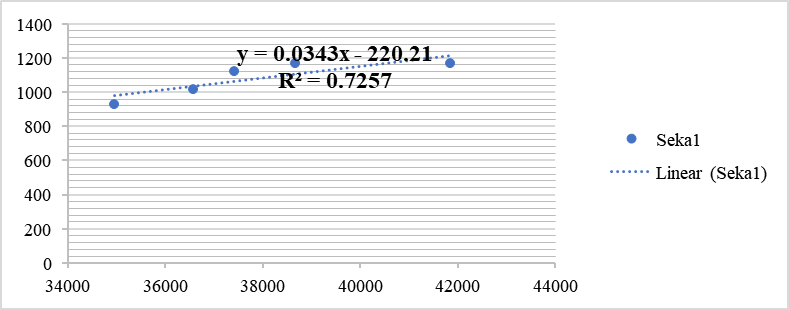
It can be noted that inbound tourism consumption has a strong positive effect on the GDP produced in the country. A correlation analysis of local tourism consumption and GDP is performed (Fig. 3) in order to determine whether inbound tourism is more important than local tourism.
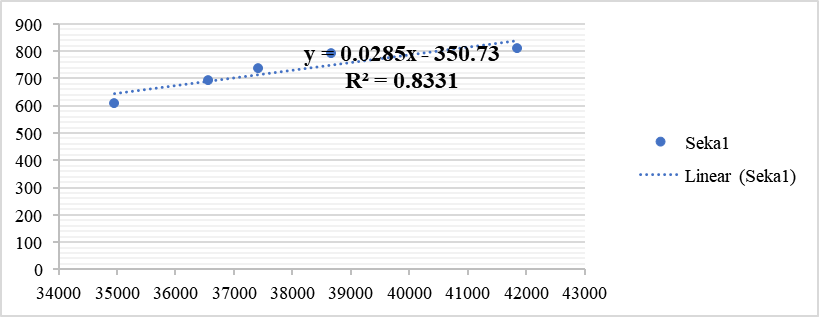
Based on the obtained correlation coefficient, it can be stated that the consumption of local tourism, as well as inbound tourism, makes a statistically significant impact on the country's GDP. Comparing the results of the correlation analysis presented in Figure
The statistical correlation analysis method was applied to analyse the impact of tourism income on Lithuanian GDP. This case checks the assumption that the income received in the tourism sector affects the overall economic situation of the country. To verify the existence of a statistically significant relationship between the analysed parameters, the Pearson correlation coefficient index is used to evaluate the obtained p value (Figure
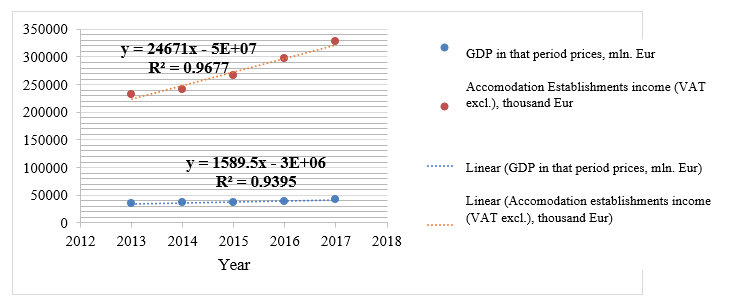
After calculating the Pearson correlation coefficient, the obtained correlation coefficient is 0.971, which indicates that there is a very strong statistical relationship between the selected variables. Based on this data, it can be stated that the income of an accommodation establishment is significant for GDP growth and therefore has a positive economic impact.
Analysing the development of tourism and focusing on accommodation establishments, it can be analysed the change of other accommodation establishments number, the number of tourists accommodated. It is possible to analyse whether the growing number of inhabited tourists could have affected the increased incomes of these institutions (Figure
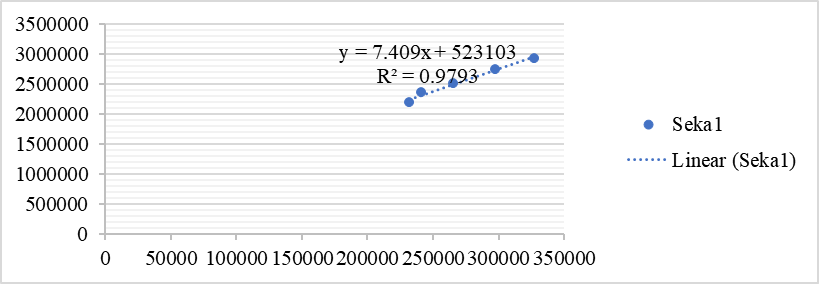
It was found that the Pearson correlation coefficient is 0.989, which indicates that there is a statistically significant relationship between the selected variables. Such calculation results are not surprising, as the income of the accommodation establishments depends directly on the flow of tourists, and as a result, income of such companies increases.
When analysing the statistical link between the accommodation establishments income and the number of institutions themselves, the correlation coefficient is equal to 0.99, indicating a statistically significant correlation between these variables. Based on these results, the changes in the tourism sector are significant to GDP generated by the country. As the network of accommodation establishments grows, its demand in the context of both local and incoming tourists increases, while helping to generate higher revenues that have a positive economic impact on the country's GDP. All these changes in accommodation establishments indicate that tourism development is economically beneficial not only for developing or creating new businesses, but also for the whole country.
When analysing the impact of tourism on the employment situation, it is very important to analyse how the development of the tourism sector can affect this indicator. In this context, it can be assumed that newly established establishments create new jobs that contribute to the overall solution to the problem of unemployment in the country. It is important to assess the statistical significance of these two variables in order to confirm or deny the impact of the number of employees working in accommodation establishments on the level of unemployment problems at country level. The calculated Pearson correlation coefficient of 0.967 reveals that there is a very strong statistical relationship between these variables. It can be concluded that the development of a network of accommodation establishments, which is considered to be one of the most characteristic economic sectors of the tourism sector, creates new jobs that contribute to the reduction of the country's unemployment rate. Thus, tourism development positively affects the country's employment situation.
Although the main focus is on the network of accommodation establishments, it is possible to briefly review other economic activities related to tourism development (Figure
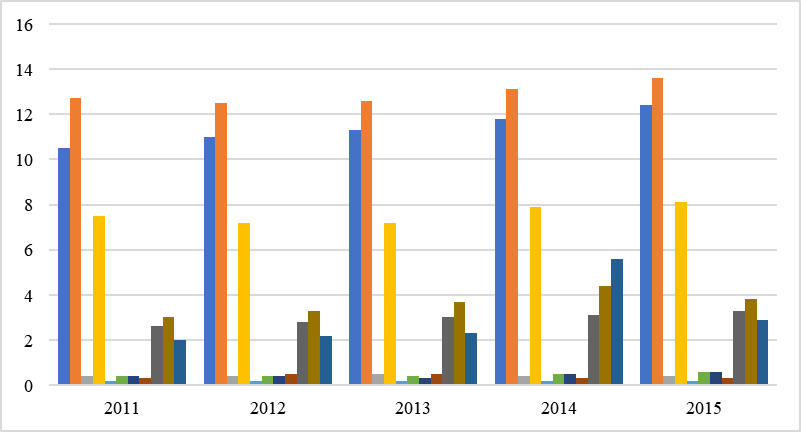
According to Figure
As the development of tourism is inseparable from the communication system, the tourism sector economic activity characteristic also includes: employees in rail, land, air and water passenger transport. The employment situation in these types of economic activity was similar during all analysed period. The share of employment in rail and water passenger transport remained unchanged, even though a slight increase in employment was recorded in 2013 while other transportation system elements faced more significant changes. Percentage of employed people in land passenger transport was 7.5% in 2011 and increased by 0.6% in 2015 and reached 8.1%. The share of passengers in air transport has increased, but only 0.2%.
The tourism sector is also integral to the activities of travel agencies. Significant growth was observed in the analysis of the number of people employed in accommodation establishments, however, no significant growth was observed in travel agencies and other similar establishments. Comparing 2011 and 2015 indicators show that the share of employment in these institutions increased by only 0.7% and in 2015 reached 3.3% of all employed people. Such indicators suggest that, unlike in the case of accommodation establishments, travel agencies and other similar activities did not become so intense in Lithuania. Such a "stagnation" can be influenced by the tourists travel habits, the demand for services offered by travel agencies does not grow so intensively. The development of information technology and the increased number of opportunities on the Internet can also be the cause. The creation of intelligent and functional apps have simplified the travel planning process for tourists, as using certain filters offer only both sides acceptable solutions in terms of time or comfort. Emerging information technologies partly affect the development of this type of economic activity, and it is not possible to see significant changes.
The employment situation has improved in both cultural activities and sports or other recreational activities, e.g., both in one and the other case - 0.8% growth over the analysed period. The increase in the number of employed persons makes it possible to assume that the supply and demand of products and services created in the tourism sector are increasing, which also results in newly created jobs that have a positive impact on the overall employment situation in the country.
2013-2017 analysis of the quantitative changes in the tourism sector has shown that this sector is becoming increasingly important for the entire economic situation in Lithuania. Assessing the consumption of tourism products, changes in accommodation establishments on the basis of incomes and their impact on GDP created in Lithuania, it was found that changes in the tourism sector have a significant impact on GDP. Summarizing the impact of tourism development on employment, it can be noted that business development in the tourism sector, the creation of new and expanding already existing enterprises create favourable conditions for the creation of new jobs. Tourism development contributes not only to the creation of new jobs, but also helps to tackle unemployment rates. As tourism development creates favourable opportunities for the creation of new businesses, it can be concluded that the creation of new businesses creates new jobs, and therefore the impact of tourism on employment cannot be ruled out.
Conclusion and Discussions
The variety of tourism development evaluation criteria promotes the analysis of tourism development not only through the economic benefit, therefore social, cultural, ecological and sustainable aspects of development also become important. The tourism sector is defined as dynamic and constantly changing, and therefore ongoing development encourages the improvement of the communication and communication infrastructure of a geographic area, the quality of people's lives, the creation of new businesses and the creation of new jobs, the promotion of greening, the use and conservation of natural resources. it is important that development takes place in different aspects. Through the consistent development of tourism, a positive image of the country is created at the international level, therefore, this sector of the economy should be given a high level of attention from the state politicians, developing a well-developed tourism policy and long-term strategies.
The impact of tourism on economic growth was assessed by analysing the changes in the GDP multiplier effect of investments attracted by tourism cluster, taxes collected, and multiplier effect. The impact of tourism on economic growth is compounded by the growing demand for tourism, which is shaped by technologies, investments, increased territories and work productivity.
Analysis of the impact of Lithuanian tourism development on Lithuania's economic growth revealed that quantitative changes in the tourism sector have a significant impact on the country's GDP. There was also a causal and statistically significant relationship between the employment situation in the tourism sector and the overall unemployment rate of the country. The consumption of tourism products / services has been analysed as one of those indicators, which revealed that with the growth of tourism consumption, while the country's GDP grows, the employment situation in the tourism sector is improving and new tourism enterprises are developing.
References
- Alvarez, D. (2014). Sustainability issues: tourism as instrument for development. Emerald Book Publishing.
- Halloway, J.C. (2012). The business of tourism. Harlow: Pearson Prentice Hall.
- Ivankovič, G. & Markelj, M. (2015). Economic aspects of preserving traditional cultural landscapes. Newcastle upon Tyne: Cmabridge Schoolar Publishing.
- Kasiulevičius, V. & Danapienė G. (2008). Statistikos taikymas mokslinių tyrimų analizėje. Gerontologija, Nr. 9(3), p. 176-180.
- Kiefl, W. (1994) Tourismus in Entwicklungsländern. Eine illusionslose Bilanz? Zeitschrift für Kulturaustausch, 3.
- Kurbatov, K. (1997). Turizm: problemy i tseli. Turizm: Praktika, problemy, perspektivy, 1 // RZH. Ekonomika promyshlennosti, 7.
- Kvartal'nov, V.A. (2000). Inostrannyy turizm. Moskova, Finansy i statistika.
- Lundberg, D. E. (1995). Tourism economics. N.Y., John Willey.
- Marikyanov, M.M. (1997). Rol' turizma v formirovanii ustoychivogo razvitiya ekonomiki. Mezhdunar. Nauch. Konf. Stud. aspirantov "Lomonosov-97": tez. dokl.-M .// RZH. Ekonomika promyshlennosti, 4.
- Mc Intosh, R. W. (1995). Tourism: principles, practices, philosophies. N.Y., John Willey.
- Occupation in the Tourist Sector: a comparative analysis in nine Community states.(1994). Europ. Centre for the Development of Vocational Training (CEDEFOP). Luxembourg.
- OECD. Publishing, & Organisation for Economic Co-operation and Development Staff. (2000). Measuring the role of tourism in OECD economies: the OECD manual on tourism satellite accounts and employment. Organisation for Economic Co-operation and Development.
- Romikaitytė, B. & Kisieliauskas, J. (2012). Lietuvos turizmo sektoriaus plėtrai įtaką darantys veiksniai. Management theory and studies for rural business and infrastructure development, Nr. 2 (31), p. 125-135.
- The evolution in holiday travel facilities and in the flow of tourism inside and outside the European Community. Part I. (1994). Commiss. of the Europ. Communities. Directorate - Gen. XXIII - Tourism Unit - Luxembourg.
- Yip, H.W., Mohd, A., Wm, W. R., & Manohar, M. (2015). Salient stakeholder identification for forestry-based ecotourism management. Newcastle upon Tyne: Cmabridge Schoolar Publishing.
Copyright information

This work is licensed under a Creative Commons Attribution-NonCommercial-NoDerivatives 4.0 International License.
About this article
Publication Date
28 January 2019
Article Doi
eBook ISBN
978-1-80296-053-2
Publisher
Future Academy
Volume
54
Print ISBN (optional)
-
Edition Number
1st Edition
Pages
1-884
Subjects
Business, Innovation, Strategic management, Leadership, Technology, Sustainability
Cite this article as:
Labanauskaitė, D., & Baranskaitė, E. (2019). The Evaluation Of Tourism Development Economic Impact Indicators In Lithuania. In M. Özşahin, & T. Hıdırlar (Eds.), New Challenges in Leadership and Technology Management, vol 54. European Proceedings of Social and Behavioural Sciences (pp. 727-738). Future Academy. https://doi.org/10.15405/epsbs.2019.01.02.62

